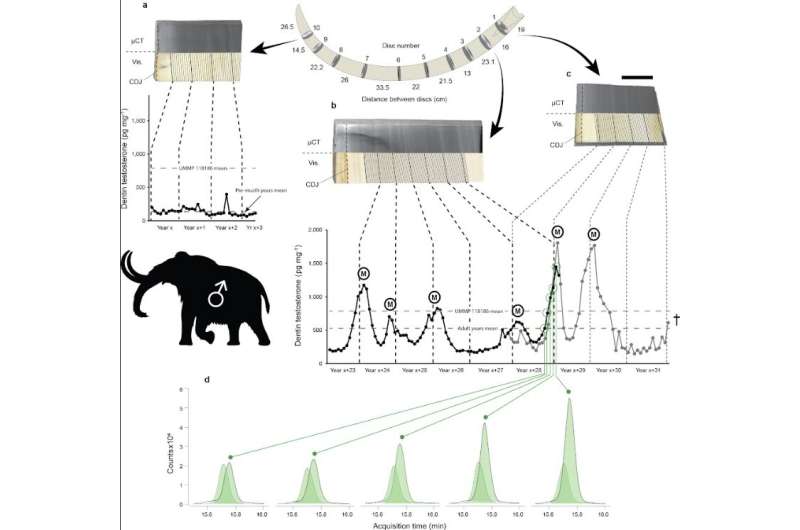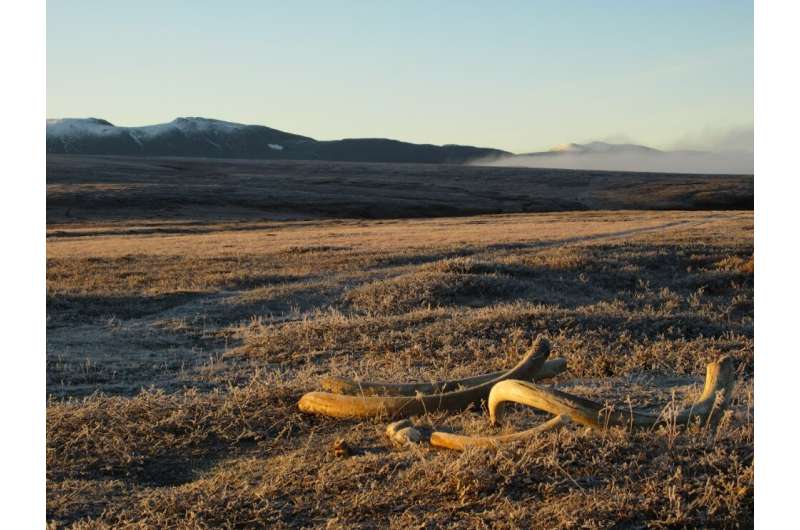This article has been reviewed according to Science X's editorial process and policies. Editors have highlighted the following attributes while ensuring the content's credibility:
fact-checked
peer-reviewed publication
trusted source
proofread
New tusk-analysis techniques reveal surging testosterone in male woolly mammoths

Traces of sex hormones extracted from a woolly mammoth's tusk provide the first direct evidence that adult males experienced musth, a testosterone-driven episode of heightened aggression against rival males, according to a new University of Michigan-led study.
In male elephants, elevated testosterone during musth was previously recognized from blood and urine tests. Musth battles in extinct relatives of modern elephants have been inferred from skeletal injuries, broken tusk tips and other indirect lines of evidence.
But the new study, scheduled for online publication May 3 in the journal Nature, is the first to show that testosterone levels are recorded in the growth layers of mammoth and elephant tusks.
The U-M researchers and their international colleagues report annually recurring testosterone surges—up to 10 times higher than baseline levels—within a permafrost-preserved woolly mammoth tusk from Siberia. The adult male mammoth lived more than 33,000 years ago.
The testosterone surges seen in the mammoth tusk are consistent with musth-related testosterone peaks the researchers observed in an African bull elephant tusk, according to the study authors. The word "musth" comes from the Hindi and Urdu word for intoxicated.
"Temporal patterns of testosterone preserved in fossil tusks show that, like modern elephants, mature bull mammoths experienced musth," said study lead author Michael Cherney, a research affiliate at the U-M Museum of Paleontology and a research fellow at the U-M Medical School.
The study demonstrates that both modern and ancient tusks hold traces of testosterone and other steroid hormones. These chemical compounds are incorporated into dentin, the mineralized tissue that makes up the interior portion of all teeth (tusks are elongated upper incisor teeth).
"This study establishes dentin as a useful repository for some hormones and sets the stage for further advances in the developing field of paleoendocrinology," Cherney said. "In addition to broad applications in zoology and paleontology, tooth-hormone records could support medical, forensic and archaeological studies."
Hormones are signaling molecules that help regulate physiology and behavior. Testosterone is the main sex hormone in male vertebrates and is part of the steroid group of hormones. It circulates in the bloodstream and accumulates in various tissues.
Scientists have previously analyzed steroid hormones present in human and animal hair, nails, bones and teeth, in both modern and ancient contexts. But the significance and value of such hormone records have been the subject of ongoing scrutiny and debate.
The authors of the new Nature study say their findings should help change that by demonstrating that steroid records in teeth can provide meaningful biological information that sometimes persists for thousands of years.
"Tusks hold particular promise for reconstructing aspects of mammoth life history because they preserve a record of growth in layers of dentin that form throughout an individual's life," said study co-author Daniel Fisher, a curator at the U-M Museum of Paleontology and professor in the Department of Earth and Environmental Sciences.
"Because musth is associated with dramatically elevated testosterone in modern elephants, it provides a starting point for assessing the feasibility of using hormones preserved in tusk growth records to investigate temporal changes in endocrine physiology," said Fisher, who is also a professor in the U-M Department of Ecology and Evolutionary Biology.
For the study, researchers sampled tusks from one adult African bull elephant and two adult woolly mammoths—a male and a female—from Siberia. The samples were obtained in accordance with relevant laws and with appropriate permits.
The researchers used CT scans to identify annual growth increments within the tusks. A tiny drill bit, operated under a microscope and moved across a block of dentin using computer-actuated stepper motors, was used to grind contiguous half-millimeter-wide samples representing approximately monthly intervals of dentin growth.
The powder produced during this milling process was collected and chemically analyzed.
The study required new methods, developed in the laboratory of U-M endocrinologist and study co-author Rich Auchus, to extract steroids from tusk dentin for measurement with a mass spectrometer, an instrument that identifies chemical substances by sorting ions according to their mass and charge.
"We had developed steroid mass spectrometry methods for human blood and saliva samples, and we have used them extensively for clinical research studies. But never in a million years did I imagine that we would be using these techniques to explore 'paleoendocrinology,'" said Auchus, professor of internal medicine and pharmacology at the U-M Medical School.
"We did have to modify the method some, because those tusk powders were the dirtiest samples we ever analyzed. When Mike (Cherney) showed me the data from the elephant tusks, I was flabbergasted. Then we saw the same patterns in the mammoth—wow!"
The African bull elephant is believed to have been 30 to 40 years old when it was killed by a hunter in Botswana in 1963. According to estimates based on growth layers in its tusk, the male woolly mammoth lived to be about 55 years old. Its right tusk was discovered by a diamond-mining company in Siberia in 2007. Radiocarbon dating revealed that the animal lived 33,291 to 38,866 years ago.

The tusk from the female woolly mammoth was discovered on Wrangel Island, which was connected to northeast Siberia in glacial periods of lower sea level but is now separated from it by the Arctic Ocean. Carbon-dating showed an age of 5,597 to 5,885 years before present. (Wrangel Island is the last known place where woolly mammoths survived, until around 4,000 years ago.)
In contrast to the male tusks, testosterone levels from the female woolly mammoth tusk showed little variation over time—as expected—and the average testosterone level was lower than the lowest values in the male mammoth's tusk records.
"With reliable results for some steroids from samples as small as 5 mg of dentin, these methods could be used to investigate records of organisms with smaller teeth, including humans and other hominids," the authors wrote. "Endocrine records in modern and ancient dentin provide a new approach to investigating reproductive ecology, life history, population dynamics, disease, and behavior in modern and prehistoric contexts."
More information: Michael Cherney, Testosterone histories from tusks reveal woolly mammoth musth episodes, Nature (2023). DOI: 10.1038/s41586-023-06020-9. www.nature.com/articles/s41586-023-06020-9
Journal information: Nature
Provided by University of Michigan





















